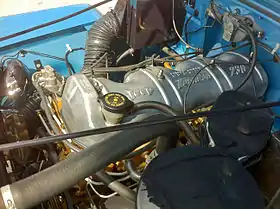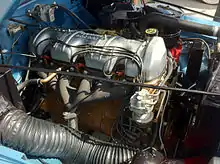Jeep Tornado engine
The Jeep Tornado engine was the first post-World War II U.S.-designed mass-produced overhead cam (OHC) automobile engine.[1] The 230.5 cu in (3.78 L) straight-six was introduced in mid-year 1962, and replaced the flathead 6-226 Willys Super Hurricane that was in use since 1954.
| Jeep Tornado | |
|---|---|
 | |
| Overview | |
| Manufacturer | |
| Also called |
|
| Production | 1962-1973 |
| Layout | |
| Displacement | 230.51 cu in (3,777 cc) |
| Cylinder bore | 3 11⁄32 in (84.93 mm) |
| Piston stroke | 4 3⁄8 in (111.13 mm) |
| Block material | Iron |
| Head material | Iron |
| Valvetrain | SOHC |
| Compression ratio | 8.5:1 or 7.5:1 |
| Output | |
| Power output |
|
| Specific power |
|
| Torque output |
|
| Chronology | |
| Predecessor | Willys Super Hurricane |
| Successor | AMC straight-6 engine |

The Tornado engine was also manufactured in Argentina by Industrias Kaiser Argentina (IKA) from 1965 to 1973.
History
The development of a new engine for Kaiser Jeep for an entirely new vehicle began under Chief Engineer, A.C. "Sammy" Sampietro, in the late-1950s.[2] Sampietro worked under Donald Healey in Europe and focused on improving power output through better engine breathing.[2] The single overhead cam design was combined with hemispheric combustion chambers.[3] Mass production of the new engine began in 1962.
The Jeep Tornado engine was introduced in the Willys Jeep Wagon and truck models.[4] Six-cylinder versions built after May 3, 1962, received the 230 OHC "Tornado" engine, replacing the 226 L-head "Super Hurricane" I6.[5] It was made the standard engine in the completely new Jeep Wagoneer station wagons (today called SUV) and Jeep Gladiator pickup trucks that began production in the fall 1962 for the 1963 model year.[6]
The Tornado was the only U.S.-built overhead-cam engine in production at that time. The new engine was designed for robust, heavy-duty performance with maximum efficiency. Its excellent fuel economy was proven in tests with the Tornado-OHC engine having the lowest specific fuel consumption of all production gasoline engines on the market.[7]
Design
The Tornado, like most Jeep engines, was undersquare for better low-speed torque. It had a 3 11⁄32 in (84.93 mm) bore with a 4 3⁄8 in (111.13 mm) stroke. The standard version had an 8.5:1 compression ratio. Output was 140 hp (100 kW) at 4000 rpm and 210 lb⋅ft (280 N⋅m) of torque at 1750 rpm. A low-compression (7.5:1) version was also available, with 133 hp (99 kW) at 4000 rpm and 199 lb⋅ft (270 N⋅m) of torque at 2400 rpm. It was a "high-efficiency" engine with a conservatively rated power output.[8]
The new engine's overhead camshaft design was only one of the advanced features offered for the first time in a U.S.-designed and mass-produced engine.[8] The Tornado was a good engine; unfortunately, it was complex (by 1960s standards) and was discontinued in civilian vehicles in the U.S. in 1965. It continued to be used in military versions of the Jeep pickup, the M-715, and M-725, until 1969. These engines had block-mounted motor mounts, rather than the front cover mounts that were a cause of oil leaks on the civilian versions.[9]
One unique feature of the design was that the camshaft only had six lobes. One lobe operated both the intake and exhaust valve for each cylinder. This made engineering cam profiles a bit more difficult than conventional two lobes per cylinder (one per valve) designs, but allowed the valves to be better arranged for the cross-flow head.[10] Valves were directly opposite their respective ports, and ports were short with wide radius turns.
Road tests of the new Jeep Wagoneer by Car Life magazine described the OHC six as "commendably smooth and quiet."[11] The engine accelerated the four-wheel-drive full-size station wagon (the SUV designation was not yet known) with an automatic transmission from 0 to 60 mph in 15.9 seconds.[11] Their tests recorded 17 mpg‑US (14 L/100 km; 20 mpg‑imp) on the highway and 14.5 mpg‑US (16.2 L/100 km; 17.4 mpg‑imp) in the city, that "certainly demonstrates the remarkable efficiency of the OHC engine."[11]
Production
Production of this engine continued in Argentina by Industrias Kaiser Argentina (IKA) after 1965. The engine was used in a variety of Jeep vehicles and American Motors (AMC) passenger cars assembled under license.[12] The engine became best known for powering the IKA-Renault Torino, a hybrid version of the AMC Rambler American and Rambler Classic (American engine and trunk compartments, Classic passenger compartment) having unique styled front and rear body parts that was built in Argentina from 1966 to 1981. It achieved international success in the 1969 Nürburgring 84-hour endurance race when a Torino placed third due to penalty points after covering 334 laps, the most of all the racers: about 9,450 kilometres (5,872 mi).[13][14][15]
The engine name was changed to "Torino" to match the car in 1973. It also received a major block and crankshaft refinement that year — seven main bearings instead of the original four. Industrias Kaiser Argentina was eventually bought out by Renault, and in 1975, the "IKA" name was dropped and it became "Renault Argentina". The Torino, Jeeps, AMC cars, as well as the Tornado engine itself, continued to receive upgrades over the years.
Argentinian Tornado engines raised output from 155 HP to 215 HP (street versions) and 250 HP to 350 HP (Racing versions). This was achieved by a new cylinder head, which improved the intake and exhaust ducts. Also adopted a new camshaft, a new exhaust manifold of a 3-1/3-1 type, two 2-inch diameter exhaust pipes, and 3 carburetors Weber DCOE 45-45.
The Torino and the Jeep Tornado engine continued production through 1982. It was marketed as the "Tornado Jet", and later as the "Tornado Interceptor", in AMC design automobiles built by IKA.[12] From 1976 to 1982, they were the only non-Renault–designed cars and engines built by the French company.[16]
Applications
The Jeep Tornado engine was used in the following vehicles:
- Willys Jeep Truck 1962-65
- Willys Jeep Wagon 1962-65
- Jeep Gladiator 1963-64
- Jeep Wagoneer 1963-64
- Kaiser Jeep M715 1963-69 (military only)
- Kaiser Jeep M725 1963-69 (military only)
- Renault Torino, also known as IKA Torino, 1966–73
- by Industrias Kaiser Argentina and Renault Argentina, in Jeep utility vehicles, the Rambler Classic and Ambassador passenger cars, from 1965–73
References
- "Kaiser Jeep". Ward's Automotive Yearbook. 26: 137. 1964. Retrieved 30 September 2020.
- Allen, Jim (August 2006). "Back To The Future: The Strange Life of Jeep's OHC 230". Off-road Adventures. Archived from the original on 24 December 2013. Retrieved 22 December 2013.
- Page, Ben. "Tornado 230 CI Engine Information / History". The International Full Size Jeep Association. Retrieved 22 December 2013.
- Foster, Patrick R. (2004). The Story of Jeep. KP Books. p. 111. ISBN 978-0-87349-735-0. Retrieved 22 December 2013.
- Allen, Jim (2004). Jeep. Motorbooks International. p. 111. ISBN 9780760319796. Retrieved 22 December 2013.
- "Meet the beautiful brute - Jeep Gladiator (advertisement)". Life Magazine. 53 (23): 23. 30 November 1962. Retrieved 30 September 2020.
- Foster, Patrick (January 2008). "1963 Jeep Wagoneer - Landmark Vehicle". 4-Wheel Drive & Sport Utility. Retrieved 30 September 2020.
- "Overhead Camshaft Design is Feature of New Willys 140 H.P. 6-cyl Engine". Autodriver: 23. 1961. Retrieved 30 September 2020.
- Allen, Jim (2007). Jeep 4x4 Performance Handbook (Second ed.). Motorbooks/MBI. p. 195. ISBN 9780760326879. Retrieved 22 December 2013.
- Allen, Jim (12 June 2012). "Classic Engine: Jeep's Tornado Straight-Six". PickupTrucks.com. Retrieved 30 September 2020.
- Auto Editors of Consumer Guide (29 August 2007). "1963-1992 Jeep Wagoneer and Grand Wagoneer". HowStuffWorks.com. Retrieved 30 September 2020.
- "Kaiser Industries in Argentina". oldcarandtruckpictures.com. Retrieved 30 September 2020.
- Orosz, Peter (8 March 2011). "When Argentina ruled the Nürburgring". jalopnik. Retrieved 30 September 2020.
- de Jong, Frank. "1969 Nurburgring 84hrs". touringcarracing.net. Retrieved 30 September 2020.
- Colombiano, Alvaro (7 December 2017). "These Are The Argentinian-Built IKA Torinos That Dominated The Nürburgring In 1969". Petrolicious. Retrieved 30 September 2020.
- "Renault Torino GR (1982 MY)". carfolio.com. Retrieved 30 September 2020.
External links
![]() Media related to Jeep Tornado engine at Wikimedia Commons
Media related to Jeep Tornado engine at Wikimedia Commons